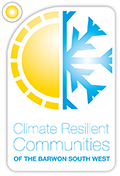Coasts and Estuaries
Coasts, coastal wetlands and estuaries are at the interface between marine and terrestrial environments. The South West region has a diverse range of natural assets that are features of the area’s coastline. The marine and coastal environments of the region include rocky reefs, pelagic waters, sand beaches, intertidal mudflats and coastal wetlands (with a connection to the sea). Equally diverse habitats include kelp forests on shallow rocky reefs, seagrass communities and mangroves.
Estuaries within the Barwon South West region are experiencing sea surface temperatures increasing at a rate of approximately four times the global average, which has potentially significant consequences for marine and estuarine species. Temperate locations (e.g. south eastern Australia) and cool water species are the most likely to be negatively impacted from increasing water temperature. Increased temperatures may exceed the optimal temperature range of certain species, particularly those species with limited thermal ranges.
The coastline of the South West region is subject to coastal erosion, sea level rise and flooding. With a changing climate these impacts will be exacerbated with increases in wind speed, storm intensity and frequency, as well as changes in rainfall intensity and frequency.
A 2005 CSIRO study indicated that mean sea level rise will provide the largest contribution to future flood risk. Under the worst-case, wind-speed scenario, storm tide height would increase by up to 5 cm in 2030 and 20 cm in 2070. The 2030 and 2070 high-wind scenarios produce increases in storm tide height that are about 19% of the respective mean sea level rises.
The current Victorian government coastal policy states ‘Plan for sea level rise of not less than 0.8 metres by 2100, and allow for the combined effects of tides, storm surges, coastal processes and local conditions, such as topography and geology when assessing risks and impacts associated with climate change’. As scientific data becomes available the policy of planning for sea level rise of not less than 0.8 metres by 2100 will be reviewed.
Current Intergovernmental Panel on Climate Change (IPCC) predictions indicate that if emissions continue to track at the top of IPCC scenarios, global average sea level could rise by nearly 1 m by 2100 (0.52−0.98 from a 1986-2005 baseline). If emissions track along the lowest scenario, then global mean sea level, (GMSL) could rise by 0.28-0.60m by 2100 (from a 1986-2005 baseline). The IPCC also state that ‘with regional variations and local factors the local sea level rise can be higher than that projected for the GMSL.
Climate change will see increases in wind speed, storm intensity and frequency and changes in rainfall frequency . These climate variables will not produce new coastal hazards but are likely to increase the extent or frequency of existing hazards. The coastline is subject to coastal inundation, coastal erosion/recession, sea level rise and flooding which will be exacerbated because of a number of factors, including changes in:
- Mean sea level
- Storm surges and storm tides
- Tidal ranges
- Wave climates
- Rainfall
Low-lying coastal wetlands and shallow wetlands rely on direct precipitation and are affected by saltwater intrusion from the sea. Climate change will therefore impact upon these ecosystems as a result of increased drought frequency and intensity, decreases in freshwater inputs, rising sea levels and increases in coastal storm surges. These conditions may also change the character of coastal wetlands through a reduction in size, conversion to dryland or a shift from one wetland type to another (e.g. brackish to saline). The retention of coastal wetland wills require planning approaches which allow for the landward movement of wetland communities in order to avert significant loss and degradation to coastal wetlands and associated biodiversity.








